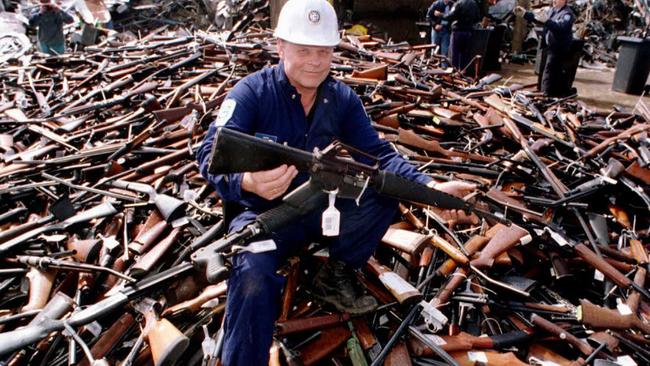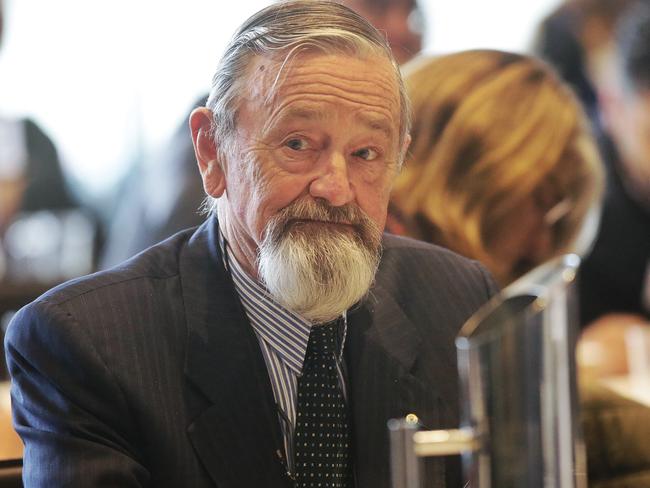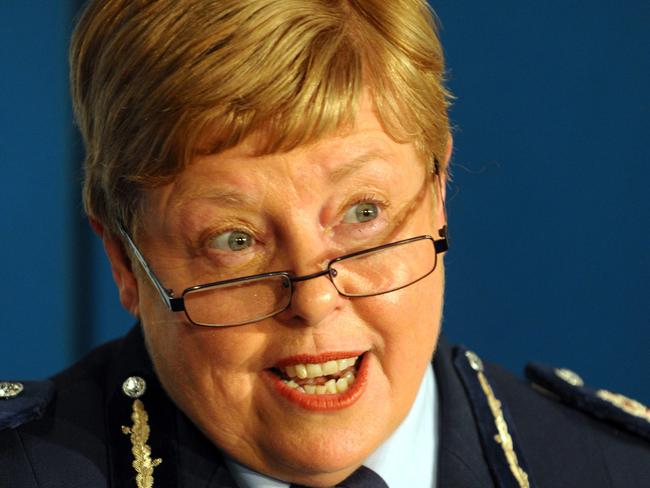Former chief police commissioner Kel Glare takes aim at force’s gun licensing branch
Former Victoria Police chief commissioner Kel Glare has raised questions over the apparent disappearance of up to 64 firearms seized by the force.

Police & Courts
Don't miss out on the headlines from Police & Courts. Followed categories will be added to My News.
Former chief police commissioner Kel Glare has taken aim at the force he headed for five years — accusing the police gun licensing branch of “impropriety and illegality” in favouring one gun dealer while penalising others.
Mr Glare has signed a detailed witness statement supporting a Geelong gun dealer’s legal action against the force over guns and ammunition missing since a police raid 11 years ago.
Human rights barrister David Hancock is representing Corio-based dealer Philip Walter in a three-day hearing before the Firearms Appeals Committee late next month.
Second-generation Geelong sports store owner Rod Haugh has confirmed that he also is briefing lawyers to challenge the police Licensing and Regulation Division over long-term losses he has suffered because of the same raids, codenamed Operation Baffler.
Mr Walter and Mr Haugh were among more than 100 small gun dealers that the Licensing and Registration Division raided in mid-2013 — confiscating hundreds of firearms and large amounts of highly-saleable and easily concealed ammunition.
Pistol ammunition commands a premium on the black market, bringing more than five times its regular retail price — which, of course, is one reason that authorities are keen to police its distribution.

In a 29-point statement, Mr Glare shoots holes in the Licensing and Regulation Division’s part in the apparent disappearance of up to 64 of the 138 guns seized in the raid on Philip Walter’s Corio premises.
He also criticises the fact that 56 of Mr Walter’s seized guns were released to another Geelong gun dealer, Jacob Stephen Hibble, who runs Wild Outdoors, the only Geelong dealership not raided in Operation Baffler.
“The release of some of these firearms to Hibble … appears to be unauthorised,” he states.
He questions why the favoured dealer, Jacob Hibble, appears to have been let sign the authority to get Walter’s guns released from the police warehouse.
The Herald Sun is not suggesting Hibble engaged in any improper or illegal conduct.
Mr Glare also questions the disappearance of two registered .17 calibre fox rifles owned by licensed Werribee shooter Zoran Tadic, who was unlucky enough to be storing both rifles in Phil Walter’s strongroom when the raid occurred.
He cites Mr Tadic’s sworn affidavit that he has never seen either of the missing rifles again — and that the LRD licensing system wrongly records him (Tadic) as the owner of a British .303 army rifle, a firearm that Mr Tadic has never owned or seen.

“I am of the opinion that there can be no reasonable explanation for the loss of these two firearms,” Mr Glare states.
“They both cannot have simply disappeared if the … the Victoria Police Manual had been followed.
“The whole process of dealing with these firearms is, in my opinion, obviously contradictory to proper procedures.
“My view is, the impropriety and illegality of the processes in the cases of both Tadic and Walter is self-evident.”
Mr Glare slams a former acting senior sergeant stating that an email the sergeant apparently sent to the storage facility’s manager Kevin Wilson in 2014 suggests the policeman is “furthering the commercial interests of a gun dealer” for no legitimate reason.
In response, a Victoria Police spokeswoman told the Sunday Herald Sun, “Victoria Police’s Licensing and Regulation Division works tirelessly to ensure its firearms register is accurate and up to date.
“To do this, it relies on dealers and licence holders providing truthful information and maintaining their own accurate records. As the matter referred to is currently before the court, we are not able to comment further.”
Spotlight thrown on what some say is shady corner of policing
If it’s proven that seized and surrendered guns and ammunition have “vanished” from Victoria Police’s storage warehouse in Collingwood, it won’t be a surprise.
The public has heard similar scandals before. Such as the episode in which detectives stole seized drugs and precursor chemicals from a police storage unit to sell to favoured criminals in the 1990s.
That racket ended when a drug squad detective blew the whistle on a bunch of crooks but it cost him his career and his peace of mind before the law finally moved against rogue cops — the real rats in the ranks.
Thieving detective Kevin Hicks was jailed, and some slippery characters quietly moved on, to the quiet relief of relatively honest colleagues.
One of the slippery set, the man known to other cops as “Grave Deed”, was publicly named after a Beretta “undercover” pistol went missing from a drawer in the drug squad. The pistol mysteriously reappeared when the alarm was raised but Grave Deed decided to resign, as did another officer subsequently charged over serious offences.

The allure of stray guns, especially pistols, has been around as long as police have. They seem to bring out the Dirty Harry in the mildest of public servants.
One ex-detective told this reporter his crew took a contraband pen pistol from a drug squad drawer and made sure it was found in the drawers (as in knickers) of drug granny Kath Pettingill — which caused her some grief and the squad much amusement.
That’s not the sort of throwaway story that amuses Kel Glare.
Cops don’t come much straighter than Glare who, after becoming chief in 1987, campaigned against corruption in his five years in the top job — and has now taken a stand against the way police apparently mishandle hundreds of seized and surrendered guns.
Glare’s statement about police actions and inaction over custody of firearms and ammunition at the force’s gun storage throws a spotlight on what some see as a shady corner of police work.
As chief, Glare oversaw a clean-up overdue since the days when SP bookmakers, abortionists and sly groggers had half the force in their pocket, a situation that set the scene for serious corruption in crime squads and red light districts.
Glare was one of a new breed of dedicated and educated officers who conceded that police should be rotated through squads and districts where temptation was high.
Except for the respected Mick Miller, Glare’s predecessors (and some contemporaries) had tolerated a “brotherhood” that let petty corruption flourish and turned a blind eye to serious breaches even if they kept their own snouts out of the trough.
During and after Glare’s time as chief, the drug squad, the licensing, gaming and vice squad and the once-notorious “armed robbers” came under stricter management, resulting in a few prosecutions and some sudden resignations, often for alleged “medical” reasons.
Under another “new broom”, interstate appointee Christine Nixon, the force became more welcoming towards minorities, but she also tried to break up corrupt cliques among drug squad and armed robbery detectives.

However, the Nixon-era wokeness didn’t extend to waking a sleepy policing backwater that went on as inefficiently as ever — with rusted-on officers and public servants trusted for many years with storing a rising tide of seized and surrendered firearms.
Gun amnesties after the Hoddle St massacre of 1987 was one reason that the old “property store” in a corner of the Russell St police complex was eventually replaced with bigger premises elsewhere.
The trickle of surrendered and seized firearms became a flood after the Port Arthur massacre in 1996. Not only were thousands of newly-outlawed semiautomatic weapons compulsorily acquired for destruction, but the public mood had swung towards surrendering all unwanted firearms as farmers and sporting shooters retired and returned soldiers died.
There were public relations photographs of containers of bent and broken guns destined for the crusher — but the reality was that not all surrendered guns were destroyed because not all reached the warehouse in the first place. Choice weapons with high collector or black market value reportedly fell through the system’s many cracks.
And of the van loads of guns that reached the warehouse, not all seized firearms were kept secure, with “shrinkage” occurring during a painfully slow and clumsy bureaucratic process to determine if, or when, their legal owners should get them back.
As highlighted by Kel Glare’s detailed statement, a broken system creates opportunity for pilfering of guns, ammunition and parts, with unexplained shortfalls dismissed with blanket excuses such as “mislaid” or “unaccounted for”.
But the shrinkage of guns and ammunition actually known to be lodged in the run-down warehouse run by the police Licensing and Regulation Division is only part of the picture. There are also “unknowns” — seized and surrendered guns that vanish without being recorded.
Shooters call unregistered guns “orphans”. There are many stories of orphans turning into ghosts at police stations all over Victoria. Of receipts not being issued at all — or being deliberately mishandled to obscure the truth.

In 2013, the police Licensing and Registration Division raided dozens of small gun dealers across Victoria, many of them regional or outer suburban specialists dealing from home premises.
Four of the police targets were Geelong-based. One of those was Phil Walter, a former army marksman working from home in the suburb of Corio.
Walter told the Sunday Herald Sun last week that the officers took 138 guns he had in his strong-room, some of them stock for sale and others held for owners who wanted them repaired or stored for safekeeping. They also took 300,000 rounds of ammunition, including rare and valuable collectables such as empty Turkish Mauser rifle shells that a relative brought back from fighting at Gallipoli.
Of the 138 guns seized, Walter says, the police recorded details of only 56. He claims most of the rest remain unaccounted for.
But it is what happened to the 56 firearms that angers Walter most. He and his advocate, former National Shooting Council vice-president Peter Zabrdac, have documents produced in Firearms Appeals Committee hearings to show that Walter’s 56 firearms were “released” to another gun dealer to resell to the public.
Among the 138 firearms seized in 2013 were two rifles owned by Werribee sporting shooter Zoran Tadic. One was a new purchase, a Savage .17 cal. rifle that Tadic lodged with Walter’s dealership, Get Along Guns, for safekeeping pending transfer of ownership from a Queensland seller. The other was a Marlin .17 cal. rifle temporarily stored by Walter pending repair or resale.
In a sworn witness statement prepared by Melbourne human rights barrister David J. Hancock, Zoran Tadic states that since police took his two rifles from Walter’s Corio premises in July 2013, he has never seen them again.
But there is a twist to Tadic’s tale. In March this year he was issued a firearms registration certificate which still does not mention his missing Savage and Marlin rifles — but which does nominate him as owner of a British .303 military rifle that he has never heard of, seen or owned.
These symptoms of a dysfunctional firearms registry happen over and over. Walter has copies of registry records with repeated examples of one gun being entered five or more times with slight variations. This means that the 138 firearms confiscated from him have spawned a list of more than 1000 separate data entries — a mess that’s confusing to everyone, probably including police and public servants mismanaging the place.
The reason for the crazily swollen list, suggests Peter Zabrdac, is that low-cost contractors have worked unsupervised to input registration data and have mangled the task, turning each gun’s details into multiple entries.
The result is a hotchpotch of botched paperwork, baffling to anyone referring to it. Which is, perhaps, perfect cover for guns, parts and ammunition to go missing, as some clearly have.
Every second shooter has anecdotal evidence of strange transactions about surrendered guns, especially handguns.
In 1995, a respected retired businessman, Alan Vivian Creaser, asked local police to visit his house at Paynesville to pick up guns that had been in his family for decades.
Creaser had three handguns: a World War I army revolver, a tiny snub-nose .32 cal. revolver his father had carried when banking cash in the 1930s and a .22 calibre Beretta pistol.
Two police officers arrived. Creaser gave them the handguns and asked for a receipt. They made vague excuses and promised to mail him the receipt.
When a younger adult relative visited shortly after, he told Creaser he had taken out a pistol licence and would like to use the Beretta for target shooting. Creaser advised going to the police station to retrieve the surrendered pistol.
The relative is now a retired sea captain, farmer and well-known regional mayor. He has never forgotten being told at the police station he was “imagining” the three surrendered pistols, and as he couldn’t produce a receipt they “didn’t exist”.
When the future mayor said he would take it to police internal affairs, the senior officer in charge allegedly turned threatening.
“Let’s see how that goes for you,” he snarled, staring down the agitated young man who left, suddenly nervous about repercussions if he persisted.




